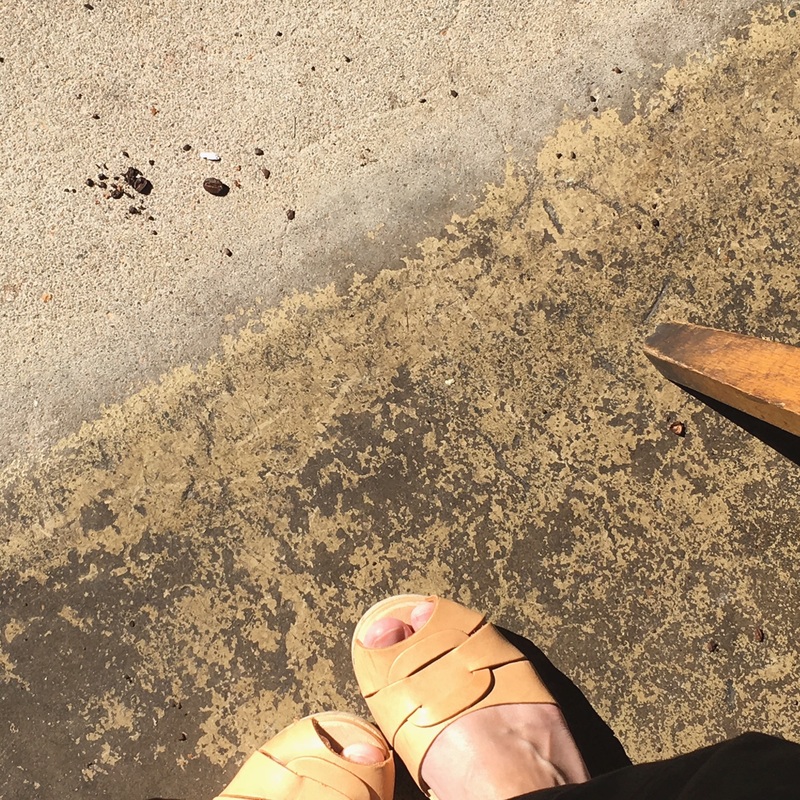My journey to a fair wardrobe started in earnest on January 1, 2015 when I pledged to “buy nothing new.” Rather than purchasing new clothes off the racks, I’m filling my wardrobe needs with thrifted apparel. I changed how I dress out of a desire to match my actions with my environmental, social, and economic beliefs.
Since 2015 all of my clothes, with the exception of intimate apparel, have been purchased secondhand. When I do buy new I consider the quality of workmanship, the material used (natural and organic fibers favored), and whether the item is USA-made or fair trade. I also sew some of my clothes using fabric I already have on hand or from upcycled materials. To increase the longevity of my wardrobe, I mend or alter clothes when necessary.
I’ve never been one to enjoy shopping, so prior to taking the pledge to “buy nothing new” I shopped the same stores for a consistent style and color palette, mainly classic attire in black, white, and denim. My wardrobe was simple, but boring and mostly not fair. An interesting thing has happened since I moved to buying secondhand—I’m bringing home pieces that have color, pattern, variety, and details that were missing before. Since I quit shopping (except for thrift stores) I no longer know what’s trendy or fashionable. It’s empowering not to be tied to fashion trends and instead dress uniquely for me.
I’m somewhat of a minimalist in all areas of my life, and my wardrobe is no exception. For me it’s possible to have less because I’m not required to own unique attire for different aspects of my life. I dress casually for work, home, and going out. When the rare occasion arises that requires a different type of dress, thrift stores become “my closet.” My husband and I attended a black tie event this year, which I pulled together an outfit for $25. After the event I donated the dress and shoes back to the thrift store.
My current favorite is a sleeveless dress I made this summer using batik fabric that was gifted to me years earlier from my mom. I love the dress paired with cowboy boots. It’s fun, flirty, and comfortable.
I really don’t. I think one of the most powerful forms of activism is voting with our dollar. By making fair clothing choices I’m taking action against social injustice, environmental degradation, and other atrocities that occur in the fashion industry. I balance the high price of fair clothing with the low, low price of thrifted clothes so my pocket book doesn’t take a hit. It also helps that I keep a minimalist wardrobe.
Buying clothes secondhand is definitely “slow fashion.” It’s taking me a long time to build a wardrobe I love. One thing that I’ve become adamant about is buying clothing made of 100 percent natural fibers. Building that into my criteria really narrows the options even further. My goal is to whittle out synthetic pieces, as well as clothing that no longer inspires me. I don’t necessarily want to grow my wardrobe; I just want to love everything in it. That takes time and patience with the approach I’m taking.
Fairly recently I started making clothes for myself again. I sewed a lot in my youth, but found it frustrating as an adult. I’d spend a lot of money on fabric and time to make, only to discover my handmade clothes didn’t fit well. I’ve started sewing again and have had more success. There are so many great independent pattern designers emerging. In fact, you have inspired me, Jane, with your series to sew more of my own clothes. I’m also more likely to sew when the investment isn’t high. All the items I’ve made in the last two years have been from fabric I already owned, found in my mom’s stash, or upcycled from thrifted items. Tracing whether fabric is “fair” is sometimes challenging and there’s such material excess that exists that I’m committed to using what’s already available.
I’m also a new knitter, having only made a hat and cowls. I’d like to continue to grow my skills and learn to knit sweaters. The biggest challenge I’ve had in buying secondhand is finding high quality wool sweaters. I’d like to fill that gap with my own handmade woolens.
For the first time ever, I’m building a wardrobe that I love and that is fair to the world. I used to think that cost money, but what I’m learning is it mostly just takes time.
We can find more of Julie and her story at thebeautyinsimple... and her lovely Instagram!
Thanks so much for inspiring us with your unique approach to fair in the closet, and thanks too for taking the Fairdare, Julie!









 RSS Feed
RSS Feed